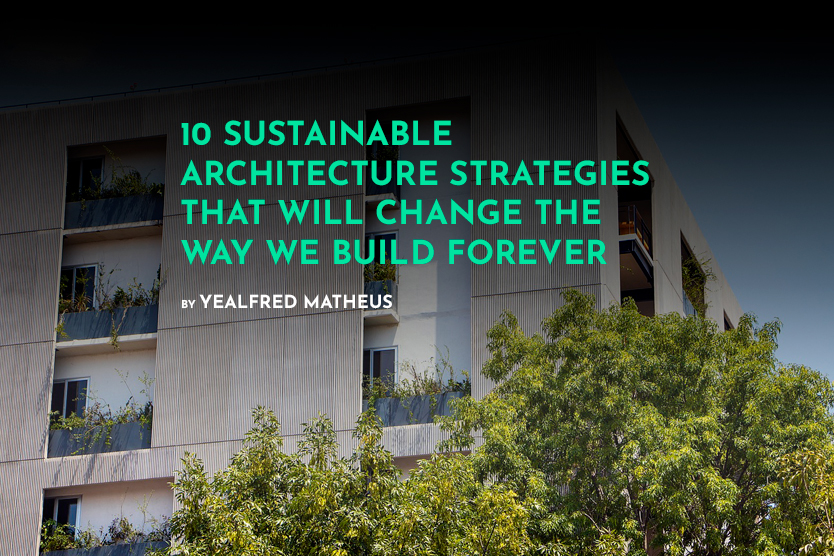
10 Ingenious Sustainable Architecture Strategies That Will Change the Way We Build Forever
Designing affordable housing and thinking green these days are not the only requirements for sustainable architecture; strategies like seeking better utilization of sunlight, creating green spaces, and rooftop gardens are also part of a series of features to promote energy savings.
Read this article in spanish: Factores y estrategias para una arquitectura sostenible
In this article:
Introduction
The need to address and attempt to solve problems affecting the quality of life of current inhabitants of the planet without compromising the ability of future generations to have resources to address their own refers directly to the modification of the natural environment, an activity inherent to architects and engineers. But it’s a multifocal approach, involving technological, political, social, economic, ecological, and ethical aspects.
“Currently in the world, we need to design more ecological buildings, we need solar energy, we need renewable energy. Energy use itself is a human behavior and we have to address it,” says Jonathan Rose, creator of a company emphasizing sustainable designs.
So… what are the 10 Sustainable Architecture Strategies?
Several factors must be evaluated for a construction project to be classified as sustainable: a project can be more or less sustainable, depending on the level of environmental impacts generated.
Contributing to problem resolution requires a set of relevant strategies, grouped into different categories aiming directly at minimizing the environmental impacts of construction, as well as contributing to the comprehensive improvement and recovery of the environment, both socially, economically, and ecologically.
Some of the sustainable architecture strategies for implementing buldings’ design are:
1. Sustainable management
This involves ensuring that the project is executed in a manner that minimizes negative environmental impacts and maximizes positive social and economic outcomes, both during construction and in the long term.
2. Consuming the minimum amount of energy and water
This highlights the importance of efficient resource use, reducing energy and water consumption not only during construction but also throughout the lifespan of the project, to minimize its environmental footprint.
3. Using eco-efficient raw materials
This focuses on selecting materials that are sustainably sourced, have low environmental impact in their production, and are efficient in terms of their performance and longevity. One example of this can be the use of wood in architecture.
4. Generating the least amount of waste possible
This emphasizes waste reduction and pollution prevention measures throughout the project lifecycle, including proper waste management and designing for ease of deconstruction or recycling at the end of its life.
5. Efficiently utilizing land
This involves optimizing land use to minimize environmental disruption, such as avoiding habitat destruction and preserving green spaces.
6. Integrating materials into the natural environment
This suggests incorporating sustainable materials and design principles that harmonize with the natural surroundings, promoting biodiversity and ecological balance.
7. Avoiding or reducing impacts on landscape
This aims to mitigate negative impacts on the local environment, including minimizing changes to the landscape, preventing heat islands, and preserving natural thermal conditions.
8. Adapting to the current and future needs of users
This underscores the importance of designing projects that are flexible and resilient, capable of meeting the evolving needs of users over time, including considerations for future growth and changes in climate.
9. Creating a healthy indoor environment
This involves designing spaces that promote occupant health and well-being, including factors such as air quality, lighting, and ergonomics.
10. Providing health and well-being to ALL living organisms
This broadens the scope to consider not only human health but also the well-being of other organisms and ecosystems affected by the project, promoting overall ecological balance and sustainability.
Building Designs for Sustainable Cities
The construction sector contributes significantly to the environmental problems of the current world, such as global warming, depletion of natural resources, air pollution, among others. If buildings are not well designed, they can also cause direct effects on health, for example, due to inadequate internal temperature variation, emission of toxic substances, noise, and even harm physical safety, in case of fires or earthquakes.
According to Rose, “climate change brings much more uncertainty for humans.”
Rose made these comments at a conference at the Harvard University Center for the Environment, entitled “The Well-Tempered City.” It was part of a series of lectures called “The Future of Energy.”
American cities have experienced a renaissance since the early 1990s. At that time, people began leaving city centers, fleeing to the suburbs. However, since then, around 70 percent of building permits have been in urban centers rather than peripheral areas.
Two demographic sectors are behind the change: the first is young people who want to live in cities “where the action is” rather than in the suburbs; the second is that many older people retire and sell the family’s large house to move to the city.
Rose aims to design buildings that promote diversity, encompassing multiple income levels and uses, such as residential and commercial spaces.
He described several projects, including one that uses a V-shaped roof to receive or avoid the sun, depending on the season. Another project, on a long, narrow plot of land, oriented from north to south (lower at the southern end and higher at the northern end), allows leveraging its topographical features to maximize sun exposure.
It also features rooms designed to maximize airflow through windows, to provide cooling during a summer blackout and for low-income residents who cannot afford air conditioning.
His designs for apartment buildings are dense, but compensated by adding nearby green spaces and rooftop gardens where possible.
For many developing countries, this option could become a sustainable and low-cost alternative, benefiting populations that have been marginalized for years and integrating them so that their inhabitants develop socially, ecologically, and economically.
This is where the ethics and interest of governments lie. Some of these countries are beginning to respond with great enthusiasm and interest to this call for achieving development that is socially just, environmentally balanced, and economically viable.


